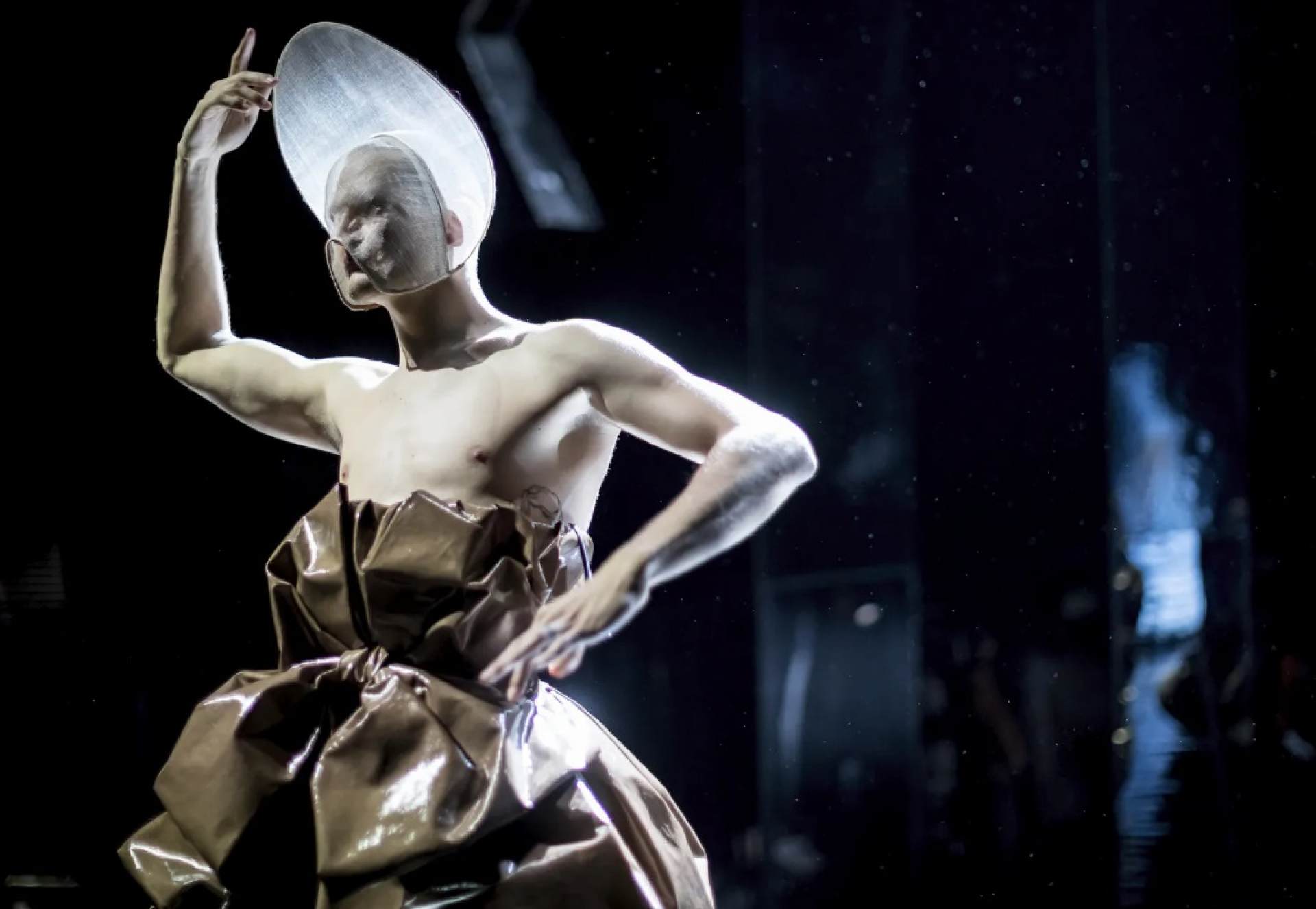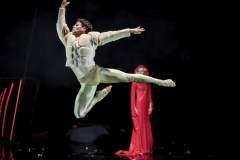Poe
Mo | Tu | We | Th | Fr | Sa | Su |
Choreographed and directed by Lenka Vagnerová.
Recomended age 14+
In Czech, surtitles in English
Morning performances from 10am do not include English surtitles.
Edgar Allan Poe and the characters of his fantastic universe are brought to life in the production prepared by Laterna magika, combining dance, singing, original music score, instrumental music, vivid stage design and striking costumes, objects, and marionettes.
“He who has never swooned, is not he who finds strange palaces and wildly familiar faces in coals that glow; is not he who beholds floating in mid-air the sad visions that the many may not view; is not he who ponders over the perfume of some novel flower—is not he whose brain grows bewildered with the meaning of some musical cadence which has never before arrested his attention.”
(Edgar Allan Poe: The Pit and the Pendulum)
The performance is inspired by selected short stories – The Pit and the Pendulum, Hop-Frog and The Masque of the Red Death, which form the basic dramaturgic structure and are interconnected with a series of atmospheres and messages as varied as Poe’s work. Edgar Allan Poe and the characters of his fantastic universe are brought to life in the performance prepared by Laterna magika, combining dance, singing, original music score, instrumental music, vivid stage design and striking costumes, objects, and marionettes. The performance is inspired by selected short stories, which form the basic dramaturgic structure and are interconnected with a series of atmospheres and messages as varied as Poe’s work. The creators open the dark corners of his soul while also revealing his brilliant sense of humour and exquisite poetry. Poe was a master of mocking as well as honouring the whole range of human characters, demonising evil and sense of power, poetising purity and beauty, and reflecting the intrinsic attributes in the character’s physiognomy. The eye-catching costumes, lyrical and hyperbolic, are funny and scary at the same time. Endless labyrinths of dark rooms and corners and omnipresent supernatural creatures – fairies, phantoms, demons, beasts – accentuate the murky atmosphere. The intangible figures materialise thanks to the Peppper’s Ghost effect, which was known in Poe’s times and was first presented to the public in 1860.
Edgar Allan Poe (1809 – 1849) is considered the founder of the detective story genre and the source of inspiration for other well-known authors, such as Arthur Conan Doyle and his Sherlock Holmes, Agatha Christie and her Hercules Poirot, or J. K. Rowling and Alfred Hitchcock. Poe also introduced the quintessential – and often ludicrous – duo of a detective and his assistant.
Program and cast
Approximate running time: 1 hour 30 minutes, no intermission
Cast
Vladimír Javorský
Tereza Maxmilián Marečková
Zhilee – Julie Goetzová
Ondřej Vinklát
Zuzana Herényiová
Tamara Kšírová
Alexandr Sadirov
Patrik Čermák
Tereza Kučerová
Vojtěch Rak
Leo Terris
Adam Sojka
Leonard Vo Tan
Monika Částková
Matilde Giacomelli
Fanny Bašista
Lukas Lizama Garrido
Jana Hampl Maroušková
Paula Morejón García
Estates Theatre
The Estates Theatre today
The Estates Theatre is one of the most beautiful historical theatre buildings in Europe. It has been part of the National Theatre since 1920. The Opera, Drama and Ballet ensembles give repertory performances at the Estates Theatre.
History
The Estates Theatre is one of the most beautiful historic theatre buildings in Europe. Its construction was initiated by the enlightened aristocrat František Antonín Count Nostitz Rieneck, led by the desire to aggrandise his native city as well as the souls of its inhabitants. The construction lasted less than two years and the Theatre was opened in 1783. This project, extremely important for the Prague of the time, was in keeping with the zeitgeist of the late 18th century, a time when national theatres were being built at European courts, royal seats and cultural centres in the spirit of the Enlightenment idea that a generally accessible theatre is a moral institution demonstrating the cultural level of the nation.
The first, sporadic Czech-language performances took place in 1785. From 1812 onwards there were regular Sunday and holiday matinees. At that time, these performances became to a certain degree a political matter too. Thus arising in the difficult years following the failed revolution in 1848 was the idea of a Czech National Theatre.
By car to the National Theatre car park
To the centre (OldTown), approach on Masarykovo nábřeží (Masaryk embankment) in the direction from the Dancing House, at the crossroads in front of the National Theatre turn right to Divadelní street and then right again to Ostrovní street to the National Theatre car park. Parking costs 50 CZK/h.
From there, walk to the Estates Theatre along Národní street, then 28. října street, turn left on to Na Můstku street and right to Rytířská street.
Other nearby secure car parks:
Kotva department store (Revoluční 1/655, Prague 1), then walk along Králodvorská street to Ovocný trh.
Palladium department store (Na Poříčí 1079/3a, Prague 1), then walk along Králodvorská street to Ovocný trh, or to the Powder Gate through Celetná street to Ovocný trh.
By tram
By daytime trams Nos. 6, 9, 18 and 22 or night trams Nos. 53, 57, 58 and 59 to the stop “Národní třída”, then by foot along Národní street, then 28. října street, turn left to Na Můstku street and right to Rytířská street.
By daytime trams Nos. 5, 8, 14 and 26 or night trams Nos. 51, 54 and 56 to the stop “Náměstí Republiky”, then on foot around the Municipal House to the Powder Gate, on Celetná street to Ovocný trh.
By daytime trams Nos. 3, 9, 14, 24 or night trams Nos. 52, 54, 55, 56 and 58 to the stop “Jindřišská”, then on foot along Nekázanka / Panská streets, turn left to Na Příkopě street and then right to Havířská street (from Na Příkopě street you can also walk through the Myslbek arcade).
By metro
To the station “Můstek”, lines A and B (green and yellow), then on foot through Na Můstku street and right to Rytířská street.

 EN
EN DE
DE IT
IT FR
FR ES
ES RU
RU JP
JP RO
RO
 Seating plan
Seating plan 


